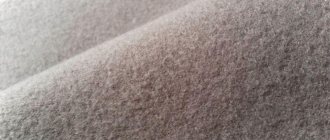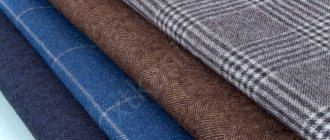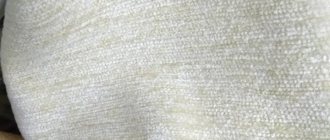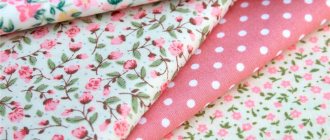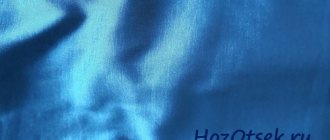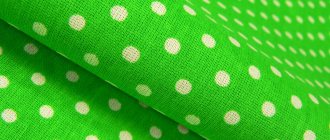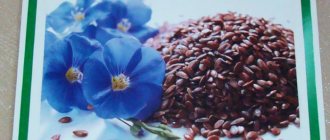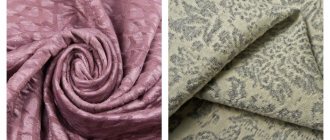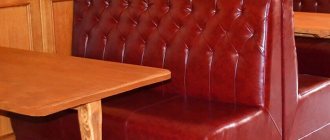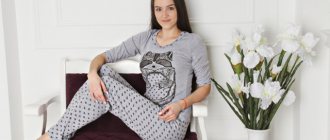Cute multi-colored women's drape coats, tailored according to the latest fashion trends, are worn with pleasure by both young girls and older ladies. Warm, comfortable, pleasant to the touch, suitable for winter frosts, autumn bad weather and spring warmth. Drape proved itself brilliantly many years ago and still retains its leading position among coat fabrics.
What kind of fabric is drape, its composition and quality
A word familiar from childhood is drape, which is associated with a large, warm winter coat. Indeed, drape is a very warm fabric, woven with a complex weave of real wool thread. This material has many varieties - with and without pile, with a clear thread pattern and smooth, plain and multi-colored. The fabric is reversible, has a distinct back and front side, and the front side is usually made of finer, high-quality wool. Modern drape contains half-woolen and synthetic threads, which makes the fabric more durable, but the wool component is significant.
To make a drape product warm and wearable, you should pay attention to the ratio of wool and impurities. The best formula, tested by time and weather - 80% wool and 20% synthetic additives.
Advantages
The material is characterized by wear resistance, and harsh varieties withstand mechanical stress better, which is why they are used in the manufacture of clothing for the military. The fabric has high breathability, on par with corduroy, viscose, and gabardine. Other advantages of the material include:
- crease resistance;
- improved thermal insulation properties;
- durability;
- resistance to burnout;
- ease of combination with other materials.
With proper care and careful handling, drapery products will last for many years and will not lose their advantages.
This season's drape coats: trends, styles, models; traditional and fashionable colors
Drape fabric fits perfectly on any cut, so the variety of models and styles is huge. This is mainly a coat, but you can sew jackets, suits, skirts, jackets and trousers - literally all products look beautiful and stylish. This season's warm clothing collections include models made entirely from drape and those combined with leather, suede, and fur.
Main models of the season
Classic trapezoidal and straight silhouettes are always fashionable and relevant, suitable for almost any figure. Tall, not overweight ladies can wear a fitted drape coat, which will emphasize their slimness.
Double-breasted styles are again relevant, not only in the usual design, but with the use of large bright buttons, the same belt, and the lower part of the collar. The colorful additions fit into the eclectic mix and match style that appeals primarily to young people. Here it is appropriate to remember the oversized style, when clothes are specially selected one size larger, creating additional volume. This technique allows you to mask some figure flaws, and skillfully selected clothes completely change your usual image.
In the spirit of the times, the “military” style is made of deliberately rough material, with all the shoulder straps, pockets, and tabs befitting a militant style. No less relevant are asymmetrical models, cut at the waist and one-piece, with uneven floors and a deep smell. Interesting models with a zipper, open or closed flap. A large metal zipper can become an additional decor for a demi-season model.
Color palette
Traditionally, drape fabric is monochromatic, with a pattern created by the interweaving of threads. The trends of modern fashion, with its richness of colors, shades, and color solutions, are perfectly embodied in drapery fabric. Plain mustard, gray, and brown colors remain in trend, but young people prefer richer colors.
Designers are developing models with purple, green, turquoise shades and pure colors that are unusual for warm products. The photo gallery presents several options for bright coats, executed in a modern style, taking into account the wishes of all segments of women's society.
Separately in high fashion collections and for everyday wear there is a cage. Photos of checkered new items and traditional models will help you choose the most interesting model that matches the color and character. It can be a polychrome Scottish or two-color Provence check, a small black and white check, or even a combination of the two types. The check is always fashionable, but now it is in favor.
Length
The length today does not reach the floor; coats usually end just below the knee. Depending on habits, age, courage, ladies allow themselves to complement a warm drape coat with equally warm trousers, tight-fitting leggings, and a straight skirt. Of course, every fashionista has the right to choose a comfortable style - long, medium or short.
Winter and demi-season models
Drape fabric is very warm, especially designed for winter cold. A winter coat can be additionally insulated with a natural or synthetic quilted lining, a large fur collar, a deep hood, and cuffs. It is warm and beautiful to cover your shoulders with a boa made of natural or artificial bio-fur. A winter coat made of drape is good form, almost a necessity for ladies. It not only helps out in any situation, but is also beautiful in itself.
Demi-season, autumn models are convenient because they are quite warm, but at the same time light, and can be tailored according to the latest fashion or remain traditional. Demi-season drape coats with a light lining are universal. By the way, there are models that are equipped with an insulating lining with a zipper, which is extremely convenient in the first days of winter, when the frost is not yet raging.
What to wear with a fashionable drape coat
Any clothing, especially warm outerwear, requires additions.
Headdress. There are not, and cannot be, any strict rules here; the main condition is that the hat, beret, and scarf must please, protect from the wind and keep you warm in the cold. Demi-season headwear can be flirty and unusual: traditional knitted hats, felt and velor berets, playful scarves, a snood scarf draped over the head.
You should choose gloves and a scarf to match the headdress. The winter version of gloves and mittens has the main purpose of warming your hands, while the demi-season version has a more decorative focus: you can decorate the gloves with embroidery, rhinestones, and appliqué. Leather gloves of all types and colors are very good. Scarves this season defy description: knitted and woven, wide and narrow, striped and plain, casually thrown over the shoulders or tied around the neck - all are good, beautiful, fashionable, the only requirement is to try to maintain the harmony of the image.
Since this season's coats are not long, the issue of suitable shoes is acute. Winter dictates its own rules: boots of all modifications, with thick soles, with natural and faux fur, with or without zippers, with cuffs, knee-high or short boots, elegant model options and affordable ugg boots. The demi-season version amazes with its variety. Shoes, ankle boots, sneakers, pumps. Heel and flat sole. Zippers, snaps, buttons and beautiful lacing.
It is highly undesirable to wear summer shoes under a coat, no matter how avant-garde it may seem. The same goes for large warm scarves - shawls, which look out of place on warm spring days. Harmony is desirable in everything, even among adherents of kitsch and avant-garde.
Story
Drape fabric first appeared in France during the Industrial Revolution. It was here that they learned to weave reliable cloth from thick and heavy yarn on special machines.
This practical and elegant material quickly gained popularity all over the world. To this day, outerwear made from it protects men and women from the autumn wind and winter frost better than any down jacket.
Caring for drape clothing
A win-win option for cleaning a winter or demi-season drape coat is dry cleaning. Our specialists know how to handle natural and mixed fabrics and you don’t have to worry about noticeable stains remaining.
If this is not possible or is undesirable for some reason, it is not difficult to clean the drape product at home. First of all, you should inspect all coats and determine the degree and quality of contamination.
The drape is easy to clean with a brush, dry or slightly damp. In case of heavy soiling, you can sprinkle the dampened area with the stain with washing powder for woolen fabrics. After the powder has dried, use the same brush to gently brush it off and then shake well.
During the summer, you should store your drape coat like regular winter clothes - straightened out on hangers, in a plastic case, with a bag of anti-mol medication hanging on the hangers.
Hot-melt adhesive gasket materials
I don’t pretend to give a complete review, but I’ll go over the main positions that I use myself.
- Dublerin is an ordinary fabric with a layer of glue applied to one side. Dublerins differ in density, base composition, extensibility, as well as the nature of application of the adhesive coating (height and frequency of glue dots). I mainly use duplerins: -collar, not too dense - thin and stretchable on a knitted basis. This is the number one stock in my workshop. Invisible, flexible, does not spoil the properties of the base, and at the same time helps to keep its shape. Improves the appearance of the most unsightly matter. Chiffon duplerin from Hensel is my main assistant. Expensive, but worth the money. - with a base like gauze. I also buy German-made ones, they are cheaper than knitted ones and are denser. I strengthen coat parts, sometimes the sides of jackets.
dublerin on a knitted chiffon base Henselcotton-based dublerin
Hensel double collar collar
- Non-woven interlining is a non-woven cushioning material with an adhesive coating. It comes in different thicknesses and densities. Thread stitched and simple. I rarely use non-woven fabrics, mainly in shirt trims or dress collars, and even then I prefer double fabric on a chiffon base. I will choose non-woven fabric if I am making a product from inexpensive fabric. I only buy thin thread stitching. Non-woven edges. There are thread-stitched and simple ones. Application: duplicating cuts, seams.
- Excellent material, comfortable, but expensive. In order to save money, I cut strips of the required width myself from the materials that I have on hand.
- Adhesive corsage tapes. This is a material for making belts. Available in different widths, single or double, with perforation along the edge, which makes marking easier and allows the belt to be perfectly straight.
- Glue webs and meshes. It's just a layer of glue, no backing. They completely kill the plasticity of the fabric, making the part “wooden”. Never buy or use them. If they are still present in your workshop, then find them and throw them away, so God forbid they stick somewhere.
corsage adhesive tapenon-woven thin
thread-stitched interlining
The most common question that arises when duplicating is: what parts should I duplicate? There are a lot of subtleties here, and in one case we will duplicate the same detail, but not in another. To understand WHAT to strengthen, you need to understand WHY. It’s like in any problem: when you understand the essence of the process, you don’t need to memorize the solution algorithm - you yourself will build it in the best possible way without any hints.
